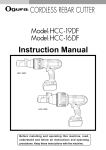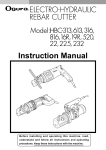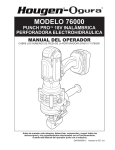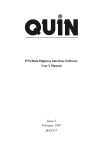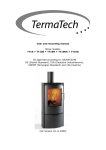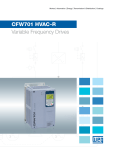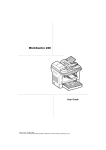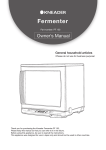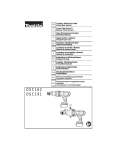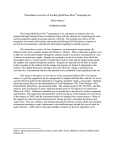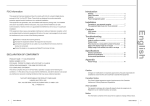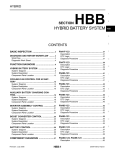Download User Manual - Metal Cutters
Transcript
Instruction Manual HPP-570 HBB-532 HBB-538 Read, understand and follow all safety instructions and operating procedures. If you do not understand the instructions or if conditions are not correct for proper operation, DO NOT OPERATE THE MACHINE. Consult your supervisor or other responsible person. TABLE OF CONTENTS SAFETY INSTRUCTIONS .................................................................................................. 3 NAMES OF THE PARTS AND SPECIFICATIONS ............................................................. 5 PUMP AND BENDER SETTING UP ................................................................................... 7 ATTACHING THE POWER CORD TO PUMP .................................................................... 7 OPERATING PROCEDURE ............................................................................................... 8 SPECIAL INSTRUCTIONS FOR BENDING AND STRAIGHTENING REBAR ................ 10 ADDING OIL ..................................................................................................................... 11 WIRING DIAGRAM ........................................................................................................... 12 WARNING Unplug power when changing tooling units, or when servicing machine. Unplug power anytime machine is not in use. Keep fingers away from cutting area during operation. Never place fingers in cutting area when machine is plugged in. Never leave machine with plug in the power source. Check that the switch is off before plugging the machine in. Turn off all switches in the event of a power interruption. Metal cutting punches dies and blades have sharp edges. Handle them carefully to avoid being cut. Any tool can shatter. Always wear eye protection. Seat material fully within cutting area. Do not use the machine in damp area or where it may become wet. Material is ejected at end of cut. Be sure that ejected slug cannot fall and cause injury. SAVE THESE INSTRUCTIONS Meaning of "caution" and "warning" indications Caution: You may be slightly or lightly injured when you cannot avoid. This is also used when only a physical injury is predicted to occur. Warning: You may die or be seriously injured when you cannot avoid. *** Ogura & Co., Ltd. shall not be responsible for any incidental damages or personal injuries resulting from negligence of Warnings and Safety Instructions contained in the Instruction Manual. 2 SAFETY INSTRUCTIONS WARNING When using electric tools, basic safety precautions should always be followed to reduce the risk of fire, electric shock, and personal injury, including the following: 1. READ ALL INSTRUCTIONS 2. Power Supply The tool should be connected only to a power supply of the same voltage as indicated on the nameplate, and can only be operated on single-phase AC supply. 3. Grounding Instructions 3a. The double insulated model can be used from sockets without earth wire. The models which are not double insulated should be grounded while in use to protect the operator from electric shock. 3b. Extension Cords Use only 3-wire extension cords that have 3prong grounding type plugs and 3-pole receptacles that accept the tool's plug. Replace or repair damaged cords. Make sure the conductor size is large enough to prevent excessive voltage drop which will cause loss of power and possible motor damage. 4. Replacement Parts When servicing use only identical replacement parts. 5. Keep Work Area Clean Cluttered areas and benches invite injuries. 6. Consider Work Area Environment Do not expose tool to rain. Do not use tool in damp or wet locations. Keep work area well lit. Do not use tool in presence of flammable liquids or gases. 7. Guard Against Electric Shock Prevent body contact with grounded surfaces. For example: pipes, radiators, ranges, refrigerator enclosures. All visitors should be kept away from work area. 9. Store Idle Tools When not in use, tools should be stored in a dry and high or locked-up place - out of reach of children. 10. Do Not Force Tool It will do the job better and safer at the rate for which it was intended. 11. Use Right Tool Do not force small tool or attachment to do the job of a heavy-duty tool. Do not use tool for purpose not intended - for example - do not use circular saw for cutting tree limbs or logs. 12. Dress Properly Do not wear loose clothing or jewelry. They can be caught in moving parts. Rubber gloves and non-skid footwear are recommended when working outdoors. Wear protective hair covering to contain long hair. 13. Always wear safety glasses or goggles 14. Do Not Abuse Cord Never carry tool by cord or yank it to disconnect from receptacle. Keep cord from heat, oil and sharp edges. 15. Secure Work Use clamps or a vice to hold work. It is safer than using your hand and it frees both hands to operate tool. 16. Do Not Overreach Keep proper footing and balance at all times. 17. Maintain Tools With Care Keep tools sharp and clean for better and safer performance. Follow instructions for lubricating and changing accessories. Inspect tool cords periodically and, if damaged, have repaired by authorized service facility. Keep handles dry, clean, and free from oil and grease. 8. Keep Children Away Do not let visitors contact tool or extension cord. 3 Important Safety Instructions 18. Disconnect Tools When not in use, before servicing, and when changing accessories, such as punches and dies. 19. Remove Adjusting Keys and Wrenches Form habit of checking to see that keys and wrenches are removed from tool before turning it on. 20. Outdoor Use Extension Cords When tool is used outdoors, use only extension cords intended for use outdoors and so marked. 21. Stay Alert Watch what you are doing. Use common sense. Do not operate tool when you are tired. 22. Check Damaged Parts Before further use of the tool, a part that is damaged should be carefully checked to determine that it will operate properly and perform its intended function. Check for alignment of moving parts, binding of moving parts, breakage or parts, mounting, and any other conditions that may affect its operation. A part that is damaged should be properly repaired or replaced by an authorized service center unless otherwise indicated elsewhere in this instruction manual. Have defective switches replaced by authorized service center. Do not use tool if switch does not turn it on and off. 23. Service at Factory Authorized Repair Center Only 24. Operating Near Welding Equipment When operating any grounded electrical equipment near an arc welder, it is important that both are connected to the same earth ground. If they are not, personal injury could result. Severe damage to the unit could also occur. 25. SAVE THESE INSTRUCTIONS Extension Cord Gauge Selection Length of Cord in Feet Nameplate Ampere Rating 115V 220V 0-2 2-3 3-4 4-5 5-6 6-8 8-10 10-12 12-14 14-16 16-18 18-20 25 Ft. 50 Ft. 18 18 18 18 18 18 18 16 16 16 14 14 50 Ft. 100 Ft. 18 18 18 18 16 16 14 14 12 12 12 12 100 Ft. 200 Ft. 18 16 16 14 14 12 12 10 10 10 8 8 150 Ft. 300 Ft. 16 14 14 12 12 10 10 8 8 8 8 6 200 Ft. 400 Ft. 16 14 12 12 10 10 8 8 6 6 6 6 250 Ft. 500 Ft. 14 12 12 10 10 8 8 6 6 6 4 4 300 Ft. 600 Ft. 14 12 10 10 8 6 6 6 6 4 4 4 400 Ft. 500 Ft. 800 Ft. 1000 Ft. 12 12 10 10 10 8 8 8 8 6 6 6 6 4 4 4 4 2 4 2 2 2 2 2 ADDITIONAL SAFETY INSTRUCTIONS FOR TOOL 1. When shipped, the tool operating pressure is correctly set. Do not change this setting as excessive operating pressure is dangerous and can cause hoses and parts to fail with risk of personal injury. 2. When operating the tool, the minimum permitted bending radius for the hoses is 100mm. Operating with a hose bending radius of less than 100mm could cause a burst hose. 3. Do not apply excessive bending forces to the hoses (especially around the coupling). If a hose is subjected to such a force the bent part is weakened and may burst. Replace any hose that is bent or deformed. 4. Do not pull the hoses during operation as this could cause disconnection of the couplings. 5. Do not subject the hoses to external pressure as this will damage the hoses and greatly reduce the hose life. 6. Do not twist the hoses as this could cause a burst hose. 7. Do not subject the tool or hoses to excessive vibration as this could cause oil leaks or a burst hose. 4 NAME OF THE PARTS AND SPECIFICATIONS HPP-570 Pressure Gauge (option) Power Cord Oil Cap Operating Switch Arm Set Dust Cover (Coupling) Cylinder Washer Bending Hook Collar HBB-532 ■ ELECTRO-HYDRAULIC PUMP Model Weight (kg) Dimensions Net (L ✕ W ✕ H) Motor (single-phase) Oil Tank Capacity Usable Oil Capacity Output Hose Length Standard Equipment HPP-570 20.5kg 257 ✕ 257 ✕ 327.5mm 1,330W (115/230V 50/60Hz) 2.2 liters 1.0 liter (approx) 1,000cc/min 3 meters Hydraulic oil, Carton Box ■ SEPARATE REBAR BENDER Model Weight (kg) Dimensions Net (L ✕ W ✕ H) Bending Capacity (Dia. mm) Grade 40: Tensile strength 490N/mm2 70,000PSI Grade 50: Tensile strength 560N/mm2 80,000PSI Grade 60: Tensile strength 620N/mm2 90,000PSI HBB-532LT 14kg 487.5 ✕ 268.5 ✕ 181.5mm HBB-532 16kg 438 ✕ 311 ✕ 172.5mm HBB-538 30.9kg 509 ✕ 356 ✕ 205mm Up to 32mm Up to 32mm Up to 38mm 5 Name of the Parts and Specifications ■ Standard Equipment ■ Bending Hook C (option) HPP-570 Spare oil (#32) ..................................................................... 150cc Plug adapter ............................................................................. 1pc HBB-532LT, 532 Hex wrenches (8mm) ............................................................... 1pc Spanner (24mm) ...................................................................... 1pc Bending roller .......................................................................... 1set *For modification of 90°inside angle (For HBB-538,120) HBB-538 Hex wrenches (8mm) ............................................................... 1pc Spanner (36mm) ...................................................................... 1pc Bending roller .......................................................................... 1set ■ Angle for Bending and Modification Bending Angle with Roller HBB-532LT HBB-532 D13 D16 D19 D22 D25 D29 D32 D38 82° 78° 69° 65° 65° 82° 78° 69° 65° 65° Bending Angle without Roller HBB-538 HBB-532LT HBB-532 96° 92° 89° 85° 81° 76° 90° 85° 80° ■ Bending angle 90° 85° 80° Inside Angle of Existing Bends Standard Hook HBB-532LT HBB-538 HBB-532 HBB-538 Pull modification Push modification 125° 108° 125° 134° 130° 113° 130° 136° 135° 118° 135° 138° 137° 120° 137° 141° 138° 121° 138° 143° 91° 145° 128° 145° 146° 87° 147° 130° 147° 148° 80° 154° ■ With Roller Inside Angle Inside Angle (Push Bending) (Pull Bending) Roller 6 Roller(set) PUMP AND BENDER SETTING UP Before the Separate Bender can be used it should be connected to the Ogura electro-hydraulic pump. Pressure Gauge (option) Coupling CAUTION Plug Only use the Separate Bender with the Ogura electro-hydraulic pump provided. Use with any other pump may cause damage to components and will impair performance. Socket 1. Connect the couplings of the two hoses from the Pump and the Separate Bender, as shown in the drawing on the left. After connecting each coupling, rotate the Sleeve so that the notch is no longer in line with the Pin. This is to prevent the coupling from being disconnected accidentally. Sleeve Pin CAUTION During use, the Pump should be placed in an upright level position with the handle on top. If operated on a slant oil may leak from the oil cap. Oil Cap 2. Before use, loosen the Oil Cap on the Pump by one turn. (For shipping and transport, the Oil Cap is tightened to avoid leaking) Loosen the Oil Cap just before starting operation and after connecting the Pump and the Separate Bender. CAUTION Operating the tool without loosening the oil cap will cause large pressure changes inside the oil tank and may result in damage to the seals and other parts. CAUTION Before disconnecting the hoses of the Separate Bender and Pump, first return the Bending Rod to its starting position (fully retracted) and then extend it about 4-5mm. After this the couplings can be disconnected. Failure to follow this procedure may cause difficulty when the couplings are to be reconnected because of trapped high oil pressure. ATTACHING THE POWER CORD TO THE PUMP Pressure Gauge (option) Sleeve Power Cord Connector 1. Insert the connector of the Power Cord into the socket on the Pump and rotate the sleeve to lock in position, as shown in the drawing on the left. Confirm that the voltage of the power supply is the same as the pump, 115 or 230V single phase. Please note that, when using an extension cord there can be a voltage drop and loss of power may occur. 2. Insert the connector of the Operation Switch into the socket on the Pump and rotate the sleeve to lock in position, as shown in the drawing on the left. Operation Switch 7 OPERATING PROCEDURE N o t e: B e f o r e o p e r a t i o n , t u r n t h e B e n d i n g H o o k counterclockwise to confirm that the Bending Hook is fixed securely to the Bending rod. Bending Rod 1. Confirm that the voltage of the power supply is the same as the voltage indicated on the name plate. 2.1 Push Bending With the Bending Rod fully retracted, position the reinforcing steel bar to be bent in the lower Hook of the Bending Rod. Push the “FORWARD” button on the Operation Switch and extend the Bending Rod to make the bend. 2.2 Pull Bending With the Bending Rod fully extended, position the reinforcing steel bar to be bent in the upper Hook of the Bending Rod. Push the “BACK” button on the Operation Switch and retract Bending Hook Arm Set Bending Rod the Bending Rod to make the bend. Note: After the bending operation is completed it will be necessary to reverse the direction of movement of the Bending Rod so that the reinforcing steel bar can be removed from the tool. ✻ Rotating function of the Bending Arm Set The Bending Arm Set with Handle can be rotated freely through 360 degrees to achieve the best position for the operating environment. Bending Hook Arm Set 2.3 To modify bends in reinforcing steel bar To change the rebar bend angle, place the Bending Hook over the centre of the bend in the rebar to be modified and operate as per paras 2. and 3. above. When the inside angle of the bend to be modified is less than the minimum angle for the standard Hook (see Table, Page 6), the optional Bending Hook C, which is suitable up to 90 degrees inside angle (For HBB-538, 120 degrees), should be used. Operation Switch CAUTION Ensure that the Bending Hook is placed over the top centre of the bend to be modified. Operating with the Hook off centre may put excessive force on the Bending Rod and Hook, resulting in damage or breakage. Bending Hook 3. The Bending Rod will continue to move as long as the “FORWARD” or “BACK” button is being pushed. The speed of movement of the Bending Rod (continual or inching) is controlled by how hard the button is pushed. Arm Set Rebar 8 Operating Procedure CAUTION To avoid damaging or breaking the Bending Hook Push Bending • The Bending Hook is screwed onto the Bending Rod and together they are free to rotate. To prevent damage to the Hook and Rod during operation ensure that the Bending Hook is screwed firmly onto the Bending Rod. See “Instructions for changing the Bending Hook” on this page. • When bending reinforcing steel bar that is fixed in Position, the tool, not being fixed, will move. Ensure that there is enough space to allow the tool to move. If there is insufficient space and the tool contacts the floor, wall, ceiling, etc., the excessive forces generated may damage or break the Bending Rod. See “SPECIAL INSTRUCTION FOR BENDING AND STRAIGHTENING REBAR” on page 10. Pull Bending Instruction for changing the Bending Hook The Bending Hook, which is screwed onto the Bending Rod, can be replaced with the optional Bending Hook C. This is done when the inside angle of a bend to be modified is too acute for the standard Bending Hook. The optional Bending Hook C is suitable up to 90 degrees. (For HBB-538, 120 degrees.) Spanner Bending Rod Up Bending Hook C (option) Arm Set 1. Hold the Bending Rod firmly with a spanner to prevent it from turning and unscrew the Bending Hook in a counter clockwise direction, to remove it from the Rod. If it is tight it may be necessary to use a spanner or bar through the hook to loosen it first. 2. Screw the optional Bending Hook C onto the Bending Rod by hand in a clockwise direction until it will go no further. Using a spanner or bar through the hook give it a final tighten to ensure that it is fully screwed onto the Rod. 3. With a spanner rotate the Bending Rod so that the opening in the Bending Hook is facing up. The Bending Hook and Bending Rod can be rotated together. The Bending Arm Set and the Bending Rod with Bending Hook can be turned to the best position for the bending situation. 9 SPECIAL INSTRUCTIONS FOR BENDING AND STRAIGHTENING REBAR To bend reinforcing steel bar that has one end fixed to the floor, wall, ceiling, etc. Bending Bending Angle B A Before Bending Pull Bending Bending Angle B A Before Bending ●When bending reinforcing steel bar close to the floor, wall, ceiling, etc., the "Pull Bending" method should be used. When "Pull Bending", the tool will move in the direction of the arrow and away from the surface, as shown in the drawing on the left. Before starting, ensure that there is sufficient space for the tool to move (see "A" and "B" in the drawing on the left and their dimensions in the following table). Push Bending A B HBB-532LT 55mm 440mm HBB-532 80mm 555mm HBB-538 71mm 600mm ●When there is not enough space for "Pull Bending", the "Push Bending" method should be used. When "Push Bending", the tool will move in the direction of the arrow and towards the floor, wall, or ceiling etc., as shown in the drawing on the left. Before starting, ensure that there is sufficient space for the tool to move (see "A" and "B" in the drawing on the left and their dimensions in the following table). A B HBB-532LT 270mm 410mm Modifying Existing Bends HBB-532 313mm 462mm Standard Hook HBB-538 336mm 518mm To modify bend in reinforcing steel bar that has one end fixed to the floor, wall, ceiling, etc. The tool will move parallel to the floor, wall, ceiling, etc., as shown in the drawing on the left. The max achievable modified angle is shown in table on page 6. Before Modifying Pull Bending Note: Up to 90 degrees of modification is possible by using the Bending Hook C (For HBB-538, 120 degrees). but it should be noted that the steel bar can fracture during the bending process depending on the material of the bar. WARNING Operating the tool where there is insufficient space (see table) will result in forced contact between the tool and obstacle causing damage to the tool and Bending Rod. Bending Hook C WARNING Do not bend material that is cracked or chipped as this may cause an accident or injury to the operator. Before Modifying 10 Pull Bending ADDING OIL The Pump, which is electro-hydraulic, is filled with oil when shipped from the factory. Do not attempt to add oil as long as the tool performs well. When the oil-pressure is not enough for the required operation, check the oil level as follows. Check the oil level. Oil Gauge The Oil Gauge Window is on the front of the Pump. If the oil level is below the red point at the center of the window, add the oil according to the following procedure. Add the oil Oil Level Pressure Gauge (option) Oil Cap Open Close Filter 1. Unscrew and remove the Oil Cap by turning it counterclockwise. 2. Unscrew and remove the Filter by turning it counterclockwise, using the screwdriver. 3. Add oil as necessary. 4. Replace the Oil Cap and the Filter. If the tool is to be used for further operations the Oil Cap should not be fully tightened but set at one complete turn before the fully tightened position. This is to allow the Oil Cap to breathe so that an equal pressure is maintained in the oil tank. Note: For transportation, the Oil Cap should be tightened securely to prevent any oil escape. Note: During use, the Pump should be placed in an upright level position with the handle on top. If operated on a slant oil may leak from the oil cap. NOTE: Only pure hydraulic oil as recommended by Ogura & Company Ltd. should be used in this tool. Use Ogura supplied hydraulic oil, Super Hyrando #32 (Nippon Oil Corporation) or anti-wear hydraulic oil, ISO Viscosity Grade 32. Do not use any other oil as this may cause damage to the gaskets and other internal machine parts. 11 12 Re Re 6 5 Re Wh 1 2 Back(pull) COB71-C9-UNKCHD20 (Forward/Back) Switch Bla 1 -3 Re PF Bl PF 1 -4 3 7 8 Bla Wh Wh 4 Forward(push) Gr PM Re Gr PM F 4 4 Re F Re Bl M Re M Bl Ye PM Wh Bla PM 1 -2 1 -1 RF Wh Bla RF F Bla 4 3 M Bla Ye Push Solenoid(Right) (W-22B-32) Ye Push Solenoid(Left) (W-22B-32) Bla 4 Motor Bla 4 Bla M Bla M F F Bl F Wh M Bl 4 Bl M Wh RM 2 -1 PF Bla S RM 2 -2 PF Wh R AC POWER Wh Gr Ground RM 2 -3 PF Gr WIRING DIAGRAM MEMO ○ ○ ○ ○ ○ ○ ○ ○ ○ ○ ○ ○ ○ ○ ○ ○ ○ ○ ○ ○ ○ ○ ○ ○ ○ ○ ○ ○ ○ ○ ○ ○ ○ ○ ○ ○ ○ ○ ○ ○ ○ ○ ○ ○ ○ ○ ○ ○ ○ ○ ○ ○ ○ ○ ○ ○ ○ ○ ○ ○ ○ ○ ○ ○ ○ ○ ○ ○ ○ ○ ○ ○ ○ ○ ○ ○ ○ ○ ○ ○ ○ ○ ○ ○ ○ ○ ○ ○ ○ ○ ○ ○ ○ ○ ○ ○ ○ ○ ○ ○ ○ ○ ○ ○ ○ ○ ○ ○ ○ ○ ○ ○ ○ ○ ○ ○ ○ ○ ○ ○ ○ ○ ○ ○ ○ ○ ○ ○ ○ ○ ○ ○ ○ ○ ○ ○ ○ ○ ○ ○ ○ ○ ○ ○ ○ ○ ○ ○ ○ ○ ○ ○ ○ ○ ○ ○ ○ ○ ○ ○ ○ ○ ○ ○ ○ ○ ○ ○ ○ ○ ○ ○ ○ ○ ○ ○ ○ ○ ○ ○ ○ ○ ○ ○ ○ ○ ○ ○ ○ ○ ○ ○ ○ ○ ○ ○ ○ ○ ○ ○ ○ ○ ○ ○ ○ ○ ○ ○ ○ ○ ○ ○ ○ ○ ○ ○ ○ ○ ○ ○ ○ ○ ○ ○ ○ ○ ○ ○ ○ ○ ○ ○ ○ ○ ○ ○ ○ ○ ○ ○ ○ ○ ○ ○ ○ ○ ○ ○ ○ ○ ○ ○ ○ ○ ○ ○ ○ ○ ○ ○ ○ ○ ○ ○ ○ ○ ○ ○ ○ ○ ○ ○ ○ ○ ○ ○ ○ ○ ○ ○ ○ ○ ○ ○ ○ ○ ○ ○ ○ ○ ○ ○ ○ ○ ○ ○ ○ ○ ○ ○ ○ ○ ○ ○ ○ ○ ○ ○ ○ ○ ○ ○ ○ ○ ○ ○ ○ ○ ○ ○ ○ ○ ○ ○ ○ ○ ○ ○ ○ ○ ○ ○ ○ ○ ○ ○ ○ ○ ○ ○ ○ ○ ○ ○ ○ ○ ○ ○ ○ ○ ○ ○ ○ ○ ○ ○ ○ ○ ○ ○ ○ ○ ○ ○ ○ ○ ○ ○ ○ ○ ○ ○ ○ ○ ○ ○ ○ ○ ○ ○ ○ ○ ○ ○ ○ ○ ○ ○ ○ ○ ○ ○ ○ ○ ○ ○ ○ ○ ○ ○ ○ ○ ○ ○ ○ ○ ○ ○ ○ ○ ○ ○ ○ ○ ○ ○ ○ ○ ○ ○ ○ ○ ○ ○ ○ ○ ○ ○ ○ ○ ○ ○ ○ ○ ○ ○ ○ ○ ○ ○ ○ ○ ○ ○ ○ ○ ○ ○ ○ ○ ○ ○ ○ ○ ○ ○ ○ ○ ○ ○ ○ ○ ○ ○ ○ ○ ○ ○ ○ ○ ○ ○ ○ ○ ○ ○ ○ ○ ○ ○ ○ ○ ○ ○ ○ ○ ○ ○ ○ ○ ○ ○ ○ ○ ○ ○ ○ ○ ○ ○ ○ ○ ○ ○ ○ ○ ○ ○ ○ ○ ○ ○ ○ ○ ○ ○ ○ ○ ○ ○ ○ ○ ○ ○ ○ ○ ○ ○ ○ ○ ○ ○ ○ ○ ○ ○ ○ ○ ○ ○ ○ ○ ○ ○ ○ ○ ○ ○ ○ ○ ○ ○ ○ ○ ○ ○ ○ ○ ○ ○ ○ ○ ○ ○ ○ ○ ○ ○ ○ ○ ○ ○ ○ ○ ○ ○ ○ ○ ○ ○ ○ ○ ○ ○ ○ ○ ○ ○ ○ ○ ○ ○ ○ ○ ○ ○ ○ ○ ○ ○ ○ ○ ○ ○ ○ ○ ○ ○ ○ ○ ○ ○ ○ ○ ○ ○ ○ ○ ○ ○ ○ ○ ○ ○ ○ ○ ○ ○ ○ ○ ○ ○ ○ ○ ○ ○ ○ ○ ○ ○ ○ ○ ○ ○ ○ ○ ○ ○ ○ ○ ○ ○ ○ ○ ○ ○ ○ ○ ○ ○ ○ ○ ○ ○ ○ ○ ○ ○ ○ ○ ○ ○ ○ ○ ○ ○ ○ ○ ○ ○ ○ ○ ○ ○ ○ ○ ○ ○ ○ ○ ○ ○ ○ ○ ○ ○ ○ ○ ○ ○ ○ ○ ○ ○ ○ ○ ○ ○ ○ ○ ○ ○ ○ ○ ○ ○ ○ ○ ○ ○ ○ ○ ○ ○ ○ ○ ○ ○ ○ ○ ○ ○ ○ ○ ○ ○ ○ ○ ○ ○ ○ ○ ○ ○ ○ ○ ○ ○ ○ ○ ○ ○ ○ ○ ○ ○ ○ ○ ○ ○ ○ ○ ○ ○ ○ ○ ○ ○ ○ ○ ○ ○ ○ ○ ○ ○ ○ ○ ○ ○ ○ ○ ○ ○ ○ ○ ○ ○ ○ ○ ○ ○ ○ ○ ○ ○ ○ ○ ○ ○ ○ ○ ○ ○ ○ ○ ○ ○ ○ ○ ○ ○ ○ ○ ○ ○ ○ ○ ○ ○ ○ ○ ○ ○ ○ ○ ○ ○ ○ ○ ○ ○ ○ ○ ○ ○ ○ ○ ○ ○ ○ ○ ○ ○ ○ ○ ○ ○ ○ ○ ○ ○ ○ ○ ○ ○ ○ ○ ○ ○ ○ ○ ○ ○ ○ ○ ○ ○ ○ ○ ○ ○ ○ ○ ○ ○ ○ ○ ○ ○ ○ ○ ○ ○ ○ ○ ○ ○ ○ ○ ○ ○ ○ ○ ○ ○ ○ ○ ○ ○ ○ ○ ○ ○ ○ ○ ○ ○ ○ ○ ○ ○ ○ ○ ○ ○ ○ ○ ○ ○ ○ ○ ○ ○ ○ ○ ○ ○ ○ ○ ○ ○ ○ ○ ○ ○ ○ ○ ○ ○ ○ ○ ○ ○ ○ ○ ○ ○ ○ ○ ○ ○ ○ ○ ○ ○ ○ ○ ○ ○ ○ ○ ○ ○ ○ ○ ○ ○ ○ ○ ○ ○ ○ ○ ○ ○ ○ ○ ○ ○ ○ ○ ○ ○ ○ ○ ○ ○ ○ ○ ○ ○ ○ ○ ○ ○ ○ ○ ○ ○ ○ ○ ○ ○ ○ ○ ○ ○ ○ ○ ○ ○ ○ ○ ○ ○ ○ ○ ○ ○ ○ ○ ○ ○ ○ ○ ○ ○ ○ ○ ○ ○ ○ ○ ○ ○ ○ ○ ○ ○ ○ ○ ○ ○ ○ ○ ○ ○ ○ ○ ○ ○ ○ ○ ○ ○ ○ ○ ○ ○ ○ ○ ○ ○ ○ ○ ○ ○ ○ ○ ○ ○ ○ ○ ○ ○ ○ ○ ○ ○ ○ ○ ○ ○ ○ ○ ○ ○ ○ ○ ○ ○ ○ ○ ○ ○ ○ ○ ○ ○ ○ ○ ○ ○ ○ ○ ○ ○ ○ ○ ○ ○ ○ ○ ○ ○ ○ ○ ○ ○ ○ ○ ○ ○ ○ ○ ○ ○ ○ ○ ○ ○ ○ ○ 13 MEMO 14 ○ ○ ○ ○ ○ ○ ○ ○ ○ ○ ○ ○ ○ ○ ○ ○ ○ ○ ○ ○ ○ ○ ○ ○ ○ ○ ○ ○ ○ ○ ○ ○ ○ ○ ○ ○ ○ ○ ○ ○ ○ ○ ○ ○ ○ ○ ○ ○ ○ ○ ○ ○ ○ ○ ○ ○ ○ ○ ○ ○ ○ ○ ○ ○ ○ ○ ○ ○ ○ ○ ○ ○ ○ ○ ○ ○ ○ ○ ○ ○ ○ ○ ○ ○ ○ ○ ○ ○ ○ ○ ○ ○ ○ ○ ○ ○ ○ ○ ○ ○ ○ ○ ○ ○ ○ ○ ○ ○ ○ ○ ○ ○ ○ ○ ○ ○ ○ ○ ○ ○ ○ ○ ○ ○ ○ ○ ○ ○ ○ ○ ○ ○ ○ ○ ○ ○ ○ ○ ○ ○ ○ ○ ○ ○ ○ ○ ○ ○ ○ ○ ○ ○ ○ ○ ○ ○ ○ ○ ○ ○ ○ ○ ○ ○ ○ ○ ○ ○ ○ ○ ○ ○ ○ ○ ○ ○ ○ ○ ○ ○ ○ ○ ○ ○ ○ ○ ○ ○ ○ ○ ○ ○ ○ ○ ○ ○ ○ ○ ○ ○ ○ ○ ○ ○ ○ ○ ○ ○ ○ ○ ○ ○ ○ ○ ○ ○ ○ ○ ○ ○ ○ ○ ○ ○ ○ ○ ○ ○ ○ ○ ○ ○ ○ ○ ○ ○ ○ ○ ○ ○ ○ ○ ○ ○ ○ ○ ○ ○ ○ ○ ○ ○ ○ ○ ○ ○ ○ ○ ○ ○ ○ ○ ○ ○ ○ ○ ○ ○ ○ ○ ○ ○ ○ ○ ○ ○ ○ ○ ○ ○ ○ ○ ○ ○ ○ ○ ○ ○ ○ ○ ○ ○ ○ ○ ○ ○ ○ ○ ○ ○ ○ ○ ○ ○ ○ ○ ○ ○ ○ ○ ○ ○ ○ ○ ○ ○ ○ ○ ○ ○ ○ ○ ○ ○ ○ ○ ○ ○ ○ ○ ○ ○ ○ ○ ○ ○ ○ ○ ○ ○ ○ ○ ○ ○ ○ ○ ○ ○ ○ ○ ○ ○ ○ ○ ○ ○ ○ ○ ○ ○ ○ ○ ○ ○ ○ ○ ○ ○ ○ ○ ○ ○ ○ ○ ○ ○ ○ ○ ○ ○ ○ ○ ○ ○ ○ ○ ○ ○ ○ ○ ○ ○ ○ ○ ○ ○ ○ ○ ○ ○ ○ ○ ○ ○ ○ ○ ○ ○ ○ ○ ○ ○ ○ ○ ○ ○ ○ ○ ○ ○ ○ ○ ○ ○ ○ ○ ○ ○ ○ ○ ○ ○ ○ ○ ○ ○ ○ ○ ○ ○ ○ ○ ○ ○ ○ ○ ○ ○ ○ ○ ○ ○ ○ ○ ○ ○ ○ ○ ○ ○ ○ ○ ○ ○ ○ ○ ○ ○ ○ ○ ○ ○ ○ ○ ○ ○ ○ ○ ○ ○ ○ ○ ○ ○ ○ ○ ○ ○ ○ ○ ○ ○ ○ ○ ○ ○ ○ ○ ○ ○ ○ ○ ○ ○ ○ ○ ○ ○ ○ ○ ○ ○ ○ ○ ○ ○ ○ ○ ○ ○ ○ ○ ○ ○ ○ ○ ○ ○ ○ ○ ○ ○ ○ ○ ○ ○ ○ ○ ○ ○ ○ ○ ○ ○ ○ ○ ○ ○ ○ ○ ○ ○ ○ ○ ○ ○ ○ ○ ○ ○ ○ ○ ○ ○ ○ ○ ○ ○ ○ ○ ○ ○ ○ ○ ○ ○ ○ ○ ○ ○ ○ ○ ○ ○ ○ ○ ○ ○ ○ ○ ○ ○ ○ ○ ○ ○ ○ ○ ○ ○ ○ ○ ○ ○ ○ ○ ○ ○ ○ ○ ○ ○ ○ ○ ○ ○ ○ ○ ○ ○ ○ ○ ○ ○ ○ ○ ○ ○ ○ ○ ○ ○ ○ ○ ○ ○ ○ ○ ○ ○ ○ ○ ○ ○ ○ ○ ○ ○ ○ ○ ○ ○ ○ ○ ○ ○ ○ ○ ○ ○ ○ ○ ○ ○ ○ ○ ○ ○ ○ ○ ○ ○ ○ ○ ○ ○ ○ ○ ○ ○ ○ ○ ○ ○ ○ ○ ○ ○ ○ ○ ○ ○ ○ ○ ○ ○ ○ ○ ○ ○ ○ ○ ○ ○ ○ ○ ○ ○ ○ ○ ○ ○ ○ ○ ○ ○ ○ ○ ○ ○ ○ ○ ○ ○ ○ ○ ○ ○ ○ ○ ○ ○ ○ ○ ○ ○ ○ ○ ○ ○ ○ ○ ○ ○ ○ ○ ○ ○ ○ ○ ○ ○ ○ ○ ○ ○ ○ ○ ○ ○ ○ ○ ○ ○ ○ ○ ○ ○ ○ ○ ○ ○ ○ ○ ○ ○ ○ ○ ○ ○ ○ ○ ○ ○ ○ ○ ○ ○ ○ ○ ○ ○ ○ ○ ○ ○ ○ ○ ○ ○ ○ ○ ○ ○ ○ ○ ○ ○ ○ ○ ○ ○ ○ ○ ○ ○ ○ ○ ○ ○ ○ ○ ○ ○ ○ ○ ○ ○ ○ ○ ○ ○ ○ ○ ○ ○ ○ ○ ○ ○ ○ ○ ○ ○ ○ ○ ○ ○ ○ ○ ○ ○ ○ ○ ○ ○ ○ ○ ○ ○ ○ ○ ○ ○ ○ ○ ○ ○ ○ ○ ○ ○ ○ ○ ○ ○ ○ ○ ○ ○ ○ ○ ○ ○ ○ ○ ○ ○ ○ ○ ○ ○ ○ ○ ○ ○ ○ ○ ○ ○ ○ ○ ○ ○ ○ ○ ○ ○ ○ ○ ○ ○ ○ ○ ○ ○ ○ ○ ○ ○ ○ ○ ○ ○ ○ ○ ○ ○ ○ ○ ○ ○ ○ ○ ○ ○ ○ ○ ○ ○ ○ ○ ○ ○ ○ ○ ○ ○ ○ ○ ○ ○ ○ ○ ○ ○ ○ ○ ○ ○ ○ ○ ○ ○ ○ ○ ○ ○ ○ ○ ○ ○ ○ ○ ○ ○ ○ ○ ○ ○ ○ ○ ○ ○ ○ ○ ○ ○ ○ ○ ○ ○ ○ ○ ○ ○ ○ ○ ○ ○ ○ ○ ○ ○ ○ ○ ○ ○ ○ ○ ○ ○ ○ ○ ○ ○ ○ ○ ○ ○ ○ ○ ○ ○ ○ ○ ○ ○ ○ ○ ○ ○ ○ ○ ○ ○ ○ ○ ○ ○ ○ ○ ○ ○ ○ ○ ○ ○ ○ ○ ○ ○ ○ ○ ○ ○ ○ ○ ○ ○ ○ ○ ○ ○ ○ ○ ○ ○ ○ ○ ○ ○ ○ ○ ○ ○ ○ ○ ○ ○ ○ ○ ○ ○ ○ ○ ○ ○ ○ ○ ○ ○ ○ ○ ○ ○ ○ ○ ○ ○ ○ ○ ○ ○ ○ ○ ○ ○ ○ ○ ○ ○ ○ ○ ○ ○ ○ ○ ○ ○ ○ ○ ○ ○ ○ ○ ○ ○ ○ ○ ○ ○ ○ ○ MEMO ○ ○ ○ ○ ○ ○ ○ ○ ○ ○ ○ ○ ○ ○ ○ ○ ○ ○ ○ ○ ○ ○ ○ ○ ○ ○ ○ ○ ○ ○ ○ ○ ○ ○ ○ ○ ○ ○ ○ ○ ○ ○ ○ ○ ○ ○ ○ ○ ○ ○ ○ ○ ○ ○ ○ ○ ○ ○ ○ ○ ○ ○ ○ ○ ○ ○ ○ ○ ○ ○ ○ ○ ○ ○ ○ ○ ○ ○ ○ ○ ○ ○ ○ ○ ○ ○ ○ ○ ○ ○ ○ ○ ○ ○ ○ ○ ○ ○ ○ ○ ○ ○ ○ ○ ○ ○ ○ ○ ○ ○ ○ ○ ○ ○ ○ ○ ○ ○ ○ ○ ○ ○ ○ ○ ○ ○ ○ ○ ○ ○ ○ ○ ○ ○ ○ ○ ○ ○ ○ ○ ○ ○ ○ ○ ○ ○ ○ ○ ○ ○ ○ ○ ○ ○ ○ ○ ○ ○ ○ ○ ○ ○ ○ ○ ○ ○ ○ ○ ○ ○ ○ ○ ○ ○ ○ ○ ○ ○ ○ ○ ○ ○ ○ ○ ○ ○ ○ ○ ○ ○ ○ ○ ○ ○ ○ ○ ○ ○ ○ ○ ○ ○ ○ ○ ○ ○ ○ ○ ○ ○ ○ ○ ○ ○ ○ ○ ○ ○ ○ ○ ○ ○ ○ ○ ○ ○ ○ ○ ○ ○ ○ ○ ○ ○ ○ ○ ○ ○ ○ ○ ○ ○ ○ ○ ○ ○ ○ ○ ○ ○ ○ ○ ○ ○ ○ ○ ○ ○ ○ ○ ○ ○ ○ ○ ○ ○ ○ ○ ○ ○ ○ ○ ○ ○ ○ ○ ○ ○ ○ ○ ○ ○ ○ ○ ○ ○ ○ ○ ○ ○ ○ ○ ○ ○ ○ ○ ○ ○ ○ ○ ○ ○ ○ ○ ○ ○ ○ ○ ○ ○ ○ ○ ○ ○ ○ ○ ○ ○ ○ ○ ○ ○ ○ ○ ○ ○ ○ ○ ○ ○ ○ ○ ○ ○ ○ ○ ○ ○ ○ ○ ○ ○ ○ ○ ○ ○ ○ ○ ○ ○ ○ ○ ○ ○ ○ ○ ○ ○ ○ ○ ○ ○ ○ ○ ○ ○ ○ ○ ○ ○ ○ ○ ○ ○ ○ ○ ○ ○ ○ ○ ○ ○ ○ ○ ○ ○ ○ ○ ○ ○ ○ ○ ○ ○ ○ ○ ○ ○ ○ ○ ○ ○ ○ ○ ○ ○ ○ ○ ○ ○ ○ ○ ○ ○ ○ ○ ○ ○ ○ ○ ○ ○ ○ ○ ○ ○ ○ ○ ○ ○ ○ ○ ○ ○ ○ ○ ○ ○ ○ ○ ○ ○ ○ ○ ○ ○ ○ ○ ○ ○ ○ ○ ○ ○ ○ ○ ○ ○ ○ ○ ○ ○ ○ ○ ○ ○ ○ ○ ○ ○ ○ ○ ○ ○ ○ ○ ○ ○ ○ ○ ○ ○ ○ ○ ○ ○ ○ ○ ○ ○ ○ ○ ○ ○ ○ ○ ○ ○ ○ ○ ○ ○ ○ ○ ○ ○ ○ ○ ○ ○ ○ ○ ○ ○ ○ ○ ○ ○ ○ ○ ○ ○ ○ ○ ○ ○ ○ ○ ○ ○ ○ ○ ○ ○ ○ ○ ○ ○ ○ ○ ○ ○ ○ ○ ○ ○ ○ ○ ○ ○ ○ ○ ○ ○ ○ ○ ○ ○ ○ ○ ○ ○ ○ ○ ○ ○ ○ ○ ○ ○ ○ ○ ○ ○ ○ ○ ○ ○ ○ ○ ○ ○ ○ ○ ○ ○ ○ ○ ○ ○ ○ ○ ○ ○ ○ ○ ○ ○ ○ ○ ○ ○ ○ ○ ○ ○ ○ ○ ○ ○ ○ ○ ○ ○ ○ ○ ○ ○ ○ ○ ○ ○ ○ ○ ○ ○ ○ ○ ○ ○ ○ ○ ○ ○ ○ ○ ○ ○ ○ ○ ○ ○ ○ ○ ○ ○ ○ ○ ○ ○ ○ ○ ○ ○ ○ ○ ○ ○ ○ ○ ○ ○ ○ ○ ○ ○ ○ ○ ○ ○ ○ ○ ○ ○ ○ ○ ○ ○ ○ ○ ○ ○ ○ ○ ○ ○ ○ ○ ○ ○ ○ ○ ○ ○ ○ ○ ○ ○ ○ ○ ○ ○ ○ ○ ○ ○ ○ ○ ○ ○ ○ ○ ○ ○ ○ ○ ○ ○ ○ ○ ○ ○ ○ ○ ○ ○ ○ ○ ○ ○ ○ ○ ○ ○ ○ ○ ○ ○ ○ ○ ○ ○ ○ ○ ○ ○ ○ ○ ○ ○ ○ ○ ○ ○ ○ ○ ○ ○ ○ ○ ○ ○ ○ ○ ○ ○ ○ ○ ○ ○ ○ ○ ○ ○ ○ ○ ○ ○ ○ ○ ○ ○ ○ ○ ○ ○ ○ ○ ○ ○ ○ ○ ○ ○ ○ ○ ○ ○ ○ ○ ○ ○ ○ ○ ○ ○ ○ ○ ○ ○ ○ ○ ○ ○ ○ ○ ○ ○ ○ ○ ○ ○ ○ ○ ○ ○ ○ ○ ○ ○ ○ ○ ○ ○ ○ ○ ○ ○ ○ ○ ○ ○ ○ ○ ○ ○ ○ ○ ○ ○ ○ ○ ○ ○ ○ ○ ○ ○ ○ ○ ○ ○ ○ ○ ○ ○ ○ ○ ○ ○ ○ ○ ○ ○ ○ ○ ○ ○ ○ ○ ○ ○ ○ ○ ○ ○ ○ ○ ○ ○ ○ ○ ○ ○ ○ ○ ○ ○ ○ ○ ○ ○ ○ ○ ○ ○ ○ ○ ○ ○ ○ ○ ○ ○ ○ ○ ○ ○ ○ ○ ○ ○ ○ ○ ○ ○ ○ ○ ○ ○ ○ ○ ○ ○ ○ ○ ○ ○ ○ ○ ○ ○ ○ ○ ○ ○ ○ ○ ○ ○ ○ ○ ○ ○ ○ ○ ○ ○ ○ ○ ○ ○ ○ ○ ○ ○ ○ ○ ○ ○ ○ ○ ○ ○ ○ ○ ○ ○ ○ ○ ○ ○ ○ ○ ○ ○ ○ ○ ○ ○ ○ ○ ○ ○ ○ ○ ○ ○ ○ ○ ○ ○ ○ ○ ○ ○ ○ ○ ○ ○ ○ ○ ○ ○ ○ ○ ○ ○ ○ ○ ○ ○ ○ ○ ○ ○ ○ ○ ○ ○ ○ ○ ○ ○ ○ ○ ○ ○ ○ ○ ○ ○ ○ ○ ○ ○ ○ ○ ○ ○ ○ ○ ○ ○ ○ ○ ○ ○ ○ ○ ○ ○ ○ ○ ○ ○ ○ ○ ○ ○ ○ ○ ○ ○ ○ ○ ○ ○ ○ ○ ○ ○ ○ ○ ○ ○ ○ ○ ○ ○ ○ ○ ○ ○ ○ ○ ○ ○ ○ ○ ○ ○ ○ ○ ○ ○ ○ ○ ○ ○ ○ ○ ○ ○ ○ ○ ○ ○ ○ ○ ○ ○ ○ ○ ○ ○ ○ ○ ○ ○ ○ ○ ○ ○ 15 R 2661 Hongo Ebina City, Kanagawa-pref., Japan 243-0417 TEL : 046-238-1284 FAX : 046-238-4188 IOJIN.0512
















